a
small introduction to the genus
This genus inside
Laeliinae has been described in 1935 based on plant collected
in Corcovado Hill (Pabst. l966) and named Pseudolaelia corcovadensis
Pôrto & Brade but the first species described was vellozicola
as Schomburgkia by Hoehne, in 1933. When Pôrto e
Brade created the new genus, they transferred it as Pseudolaelia
vellozicola (Hoehne) Pôrto & Brade. It has been
published in Arquivos do Instituto de Biologia Vegetal.
According to Pabst (l976), the genus is characterized by having 8 pollinia,
tied in group of two, as found in Laelia, by the structure of
the column and the vegetative habit of the plant with its long rhizome
of 10 cm (or more) long, the homoblastic pseudobulbs covered by sheath
of the inferior leaves and by the big inflorescence from 50 - 80 cm
long.
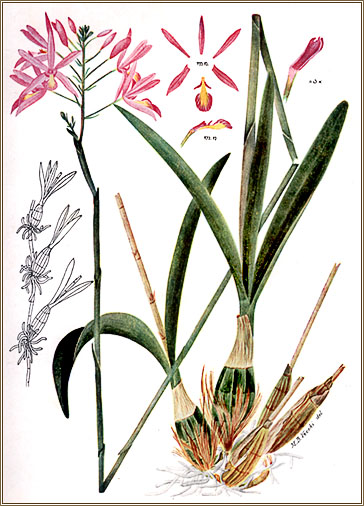
pseudolaelia
vellozicola (Hoehne illustration)
Pseudolaelia
is not very well known genus in spite of having 12 species (4 are recently
described) and a natural hybrid (also recently described).
It is endemic to Brazil and, except for Pseudolaelia corcorvadensis
in state of Rio de Janeiro (including Rio de Janeiro city) and Pseudolaelia
vellozicola (Hoehne) Pôrto & Brade in Bahia (1), the species
are restrict to the states of Minas Gerais and Espírito Santo.
The last state is the center of distribution of the genus with 10 species.
Minas Gerais has 8 species and three of them are endemic (Pseudolaelia
cipoensis Pabst, Pseudolaelia geraensis Pabst and Pseudolaelia
irwiniana Pabst).
In 1946, eleven years after the description of the genus, Augusto Ruschi
described a new genus (Renata) based on a species he named Renata
canaanensis and published it in Publ. Arq. Público Estado
Espírito Santo 1946. Later, in 1994, it has been transferred,
by Fabio de Barros, to the genus Pseudolaelia.
So until 1949, when Ruschi described P. dutrae, the genus stayed
with only two species.
In 1967, it means, almost 20 years later, Pabst described a new species:
Pseudolaelia geraensis.
In 1973, he described two more species P. irwiniana and P.
cipoensis.
In 1976, he described Pseudolaelia citrina which was
his last description of a species inside the genus although he had,
at least, two another plants that he considered as new species (see
bellow).
In 1991, Rui J.V. Alves described a species (Pseudolaelia lymansmithii)
occurring in the state of Minas Gerais, Brazil and published it in Folia
Geobot. Phytotax, Praha 27:189-191 9- Kolbek J. & Alves but in l994,
Fabio de Barros considered as synonym of Epidendrum campestre
Lindl.
So we should wait for more 27 years to know another species. Michel
Frey, a French expert living in Brazil, who has been studying this genus
for long time, started to bring to lights of the science the results
of his amazing discoveries: four new species (perhaps five) and a natural
hybrid:
He published Pseudolaelia brejetubensis (2003), Pseudolaelia
maquijiensis (2005), Pseudolaelia pavopolitana (2005) and
Pseudolaelia x perimii (Pseudolaelia brejetubensis Frey x
Pseudolaelia freyi Chiron & V. P. Castro) (2005) .
In 2004, Chiron & V.P. Castro published Pseudolaelia freyi.
This paper would be part of a work which would include an interview
with Michel Frey about his researches in Brazil. Unfortunately he has
just passed away making us very upset with this lost. In November 2005,
we have talked about this interview for the first time but he was leaving
Brazil to go to France so we decided to let it for 2006. We started
the work in earl April and in one of his last messages when he gave
some information about the occurrence of Pseudolaelia, he finished like
this: "Voilà un petit sandwich en attendant le gros repas",
it means: There is a sandwich while waiting for the big dinner.
This new got us the moment we were putting on air this edition.
We render homage to Michel Frey.
| |
P
& D Number |
Species
|
Description |
Hab |
Color |
Altitude |
St |
St |
St |
St |
| 01 |
|
Pseudolaelia
brejetubensis M. Frey |
2003 |
R |
from
white to soft pink. |
1100/1400 |
ES |
MG |
|
|
| 02 |
932 |
Pseudolaelia
canaanensis (Ruschi) F. Barros |
1946 |
R |
Yellow/Greenish |
300/1.000m |
ES |
|
|
|
| 03 |
933 |
Pseudolaelia
cipoensis Pabst |
1973 |
E |
Purple |
1400m |
|
MG
|
|
|
| 04 |
|
Pseudolaelia
citrina Pabst |
1976 |
E |
Greenish
and yellow lemon lip |
1200m |
ES
|
MG |
|
|
| 05 |
934 |
Pseudolaelia
corcovadensis Pôrto & Brade |
1935 |
E |
Dark
Pink |
500/700m
|
ES |
MG |
|
RJ |
| 06 |
935 |
Pseudolaelia
dutrae Ruschi |
1949 |
E |
Soft
Pink |
400/700m |
ES |
MG |
|
|
| 07 |
|
Pseudolaelia
freyi Chiron & V.P. Castro |
2005 |
E |
Soft
Pink/White |
1100/1400m |
ES |
|
|
|
| 08 |
936 |
Pseudolaelia
geraensis Pabst |
1967 |
E |
Lilac |
|
|
MG |
|
|
| 09 |
937 |
Pseudolaelia
irwiniana Pabst |
1973 |
E |
Dark
Pink |
900m |
|
MG
|
|
|
| 10 |
|
Pseudolaelia
maquijiensis M. Frey |
2005 |
R |
Yellow/Greenish |
700m |
ES |
|
|
|
| 11 |
|
Pseudolaelia
pavopolitana M. Frey |
2005 |
R |
Yellow/Greenish |
350m |
ES |
|
|
|
| 12 |
938 |
Pseudolaelia
vellozicola (Hoehne) Pôrto & Brade |
1933 |
E |
Dark
Pink |
since
sea level |
ES |
MG |
BA |
|
| 13 |
|
Pseudolaelia
x perimii M. Frey |
2005 |
R |
variable |
1100/1400 |
ES |
|
|
|
The main host of the genus is Vellozia but some species are rupicolous.
Notes:
R = rupicolous
E = Epiphyte
(1) - Inclusion of the state of Bahia - Carl L. Withner - The Cattleyas
and Their Relatives, Volume III and also exsicata filed in the Herbarium
Bradeanum (Maracás- Bahia - see bellow).
(2) - Pabst G. F.J. & F. Dungs, 1975 - Orchidaceae Brasilienses -
Vol 1- K. Schmersow, Hildesheim
(*)
Pseudolaelia brejetubensis M.
Frey
Bradea V (8):33-36
Typus: Brazil, Espírito Santo, Brejetuba, Monte Feio,
1100-1400 m.s.m VI 2001 (fl) Mr Frey 30 & l. C. F. Perrim
(Holotypus: RB).
It also occurs in Minas Gerais, near to the boundary with
Espírito Santo (M. Frey)
|
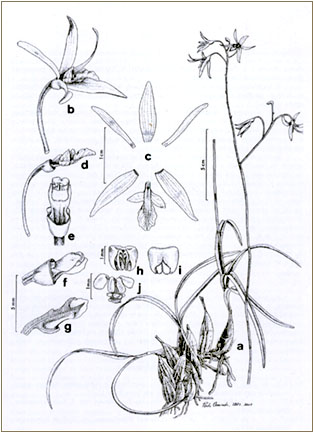 |
Pseudolaelia
canaanensis (Ruschi) F. Barros
Hoehnea - volume 29 |
(*)
Pseudolaelia cipoensis Pabst
Bradea vol I(36) 365:366 e 370 - 1973
"Habitat: Minas Gerais, Serra do Cipó, c.
1400 msm. Leg. Dr. Br Antón Ghillány, nº 209,
15 Mai. 1970 - Holotypus HB-57099.
This new species of Pseudolaelia belongs to the group of wide
petals character of P. corcovadensis and P. geraensis from which
it is easily distinguished by the shape of the lip. Pseudolaelia
dutrae and P. vellozicola have rather narrow petals'.
|
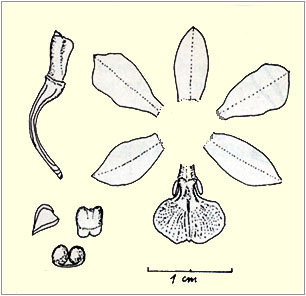 |
(*)
Pseudolaelia citrina
Pabst
Bradea vol II (12) 69:70 - 1976
"Habitat: Minas Gerais, pr. Ibiraçu, 1200msm, epiphyta
in Velloziaceae, soli prorsus exposita. Legit R. Kautsky nr 490,
7. MAJ. 1975. Holotypus-HB.
By the color yellow-citrin of the flowers which are really small,
this new species distinguishes since the first sight. To whom who
consider Pseudolaelia as an hybrid , Pseudolaelia citrina will make
troubles to discover which are the parents".
It grows exposed to the sun on Vellozia.
|
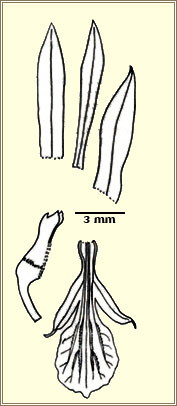 |
Pseudolaelia
corcovadensis Pôrto & Brade
It grows on Corcovado Hill on Vellozia. It has been
also found in Tijuca, São José do Rio Preto and
Maria Madalena mountains (Pabst l976). H. S. Irwin e S.F. da
Fonseca & R. Souza have found this species in Minas Gerais,
Diamantina, at 900 m (Missouri Botanical Garden).
It has been only found as epiphyte growing in Velozias
always in altitudes reached by the clouds which supply copious
humidity to the region (Pabst l976).
|
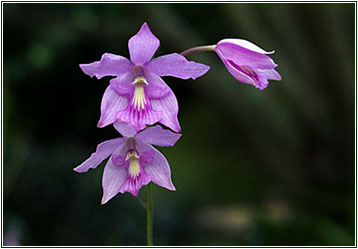 |
|
|
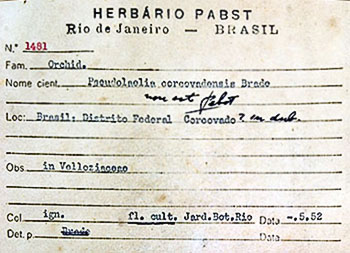 |
Pseudolaelia
dutrae Ruschi
Boletim do Museu de Biologia Mello Leitão 1: 40. 1949.
"Habitat: Espírito Santo. Santa Tereza. Barra
do Rio Perdido. Alt 400-600ms. Epiphyta ad Velloziaceae. Exemplar
tipo Herbario Museu de Biologia Professor Mello Leitão
nº 1501". |
Pseudolaelia
freyi Chiron & V.P. Castro, Richardiana Vol IV (4) 155:162
- 2004
(see in Novelties in Pseudolaelia) |
(*)
Pseudolaelia geraensis Pabst
Orquídea 29: 63. 1967.
Habitat: Brasil - Minas Gerais, in saxis calcaris ad marginem
viae Nanuque - Teófilo Otoni. Leg. R. P. Belém nº
1629. 14 Aug. 1965 (Holotypus Ceplac - Cepec - Herbario nº
1854. Itabuna).
The new species in closest to Pseudolaelia corcovadensis with
which it has in common the broad sepals and petals the lip is interely
different however."
|
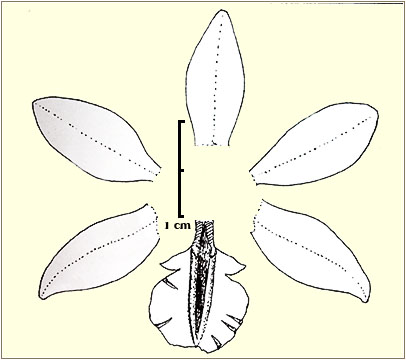 |
(*)
Pseudolaelia irwiniana Pabst
Bradea vol I(36) 366:367 e 370 - 1973
"Habitat: Minas Gerais, 18km. E. of Diamantina,
cerrado interspead with oucrops, 900msm. Leg H. S. Irwin, Fonseca,
Souza e Ramos Nr. 27706, 16 Mar. 1970, Holotypus - UNB, Isotypi
NY, HB.
This new species is closest related to P.Corcovandenis Porto
& Brade, differring in the shape of its petals and lip and
inth much shorter and relatively thicker column".
Also found in Serra do Caraça ( Wladyslaw Zaslawski
in Orchid News #28)
(http://www.delfinadearaujo.com/on/on28/paginas/wlad2.htm) |
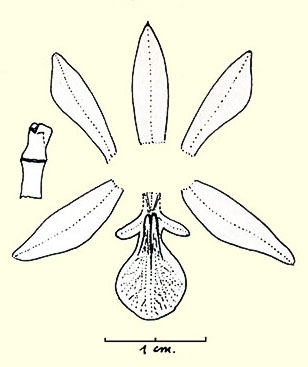 |
Pseudolaelia
maquijiensis M. Frey
Richardiana Vol V (1) 39:45 - 2005
(see in Novelties in Pseudolaelia) |
Pseudolaelia
pavopolitana M. Frey
Richardiana Vol V (4) 202:209 - 2005
(see in Novelties in Pseudolaelia) |
Pseudolaelia
vellozicola (Hoehne) Pôrto &
Brade
Arquivos do Instituto de Biologia Vegetal 2: 211. 1935.
Pseudolaelia vellozicola grows in the "restinga"
(coastal vegetation), in the state of Espírito Santo,
as epiphyte (Cláudio Nicoletti de Fraga e Ariane Luna
Peixoto).
Hoehne, in page 98, in Iconografia de Orchidaceas do Brasil,
mentioned "that in the rocks exposed to the sunbeam,
in the high part of Tijuca, grows under Vellozia the interesting
Schomburgkia vellozicola (Pseudolaelia) which
also grows in Serra do Caraça, Minas Gerais".
Probably he was talking about Pseudolaelia corcovadensis
when he talked about Tijuca which has been found in June
1935, in Corcovado. |
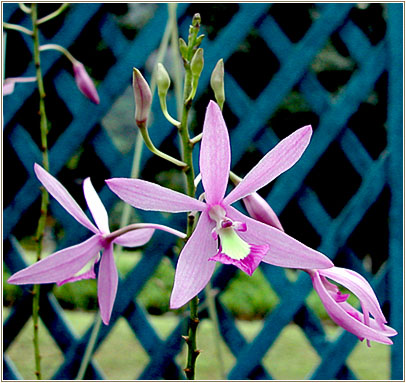 |
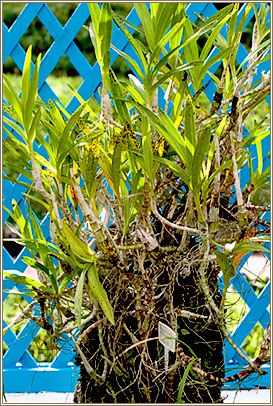 |
Pseudolaelia
x perimii M. Frey
Richardiana Vol V (3) 158:164- 2005
(see in Novelties in Pseudolaelia) |
When we consider to study orchid Brazilian species (and specially Pseudolaelia),
we should consider to research at Herbarium Bradeanum (HB). Between
the 880 types distributed by 53 families, we should emphasize that HB
has one of the most important collection of Orchidaceae family
(257) which corresponds to 10% of the total patrimony of this institution.
However, the most interest preciosities of the HB is Pabst's card index
which is formed by 38.961 registers with information about orchids species.
Those cards were the basis of the book "Orchidaceae Brasilienses".
All information concerning genera and species of the Orchidaceae
family, he could gather, was carefully transcribed in those cards: photocopies
and original works about genera, such as "princeps" works,
re-descriptions, species, keys to identify, types, phototypes (photography
of the types), species, flattened perianths, basionyms, synonyms, watercolors
by Samuel Salgado and Margarete Mee, besides the register of the exsicatas
which are filed in Herbarium Bradeanum. The holotypus of Pseudolaelia
cipoensis Pabst and Pseudolaelia citrina Pabst and the isotypus
of Pseudolaelia irwiniana Pabst are stored there. Some precious
information about Pseudolaelia are found there. There are, at
least, 30 cards concerning Pseudolaelia and between them, there
is one which immediatly calls our attention: very small pressed flowers
collected in Maria Madalena, by Brade.
However, the big surprises are in the collection of Pseudolaelia
exsicatas. Between them, there is one that is not identified and there
are two that, in spite of having a name (the first one given by Pabst
and the second by Toscano de Brito), the plantas have not been described.
We don't know if Pabst hadn't time to do this or if later, he considered
as a not valid species.
|
The
first one is the file 67152, an unidentified species, where is written:
"from Espírito Santo, Castelo, Forno Grande, Lajão
1.200m alt. Epiphyte on Velloziacea. Fleur Purple. Collected by
A. C. Brade in 19781 in 12.V. 1949".
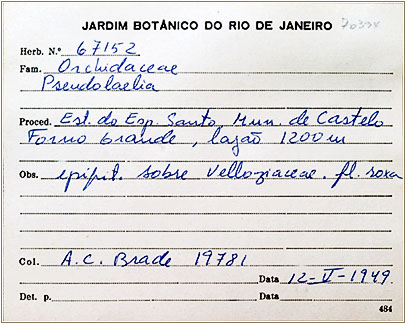 |
The seconde one is the 63 562 file where is written: Pseudolaelia
ghillany Pabst. Loc. Bahia - Maracás. Epiphyte on Vellozia
with white flowers. Collected by A. Ghillany & R. Windish.
10.7.76.
(not described)
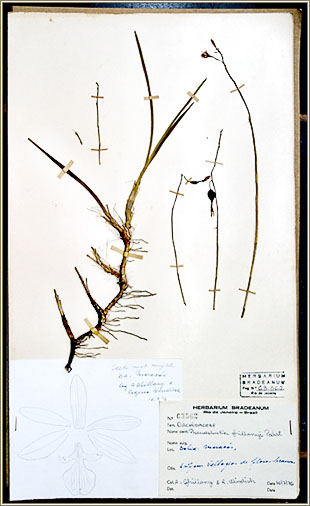 |
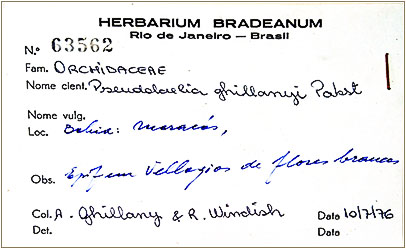 |
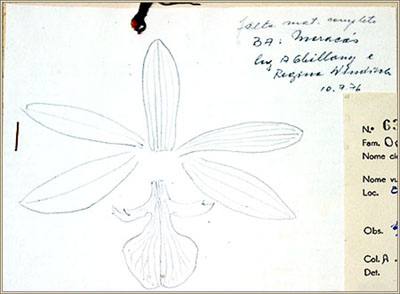 |
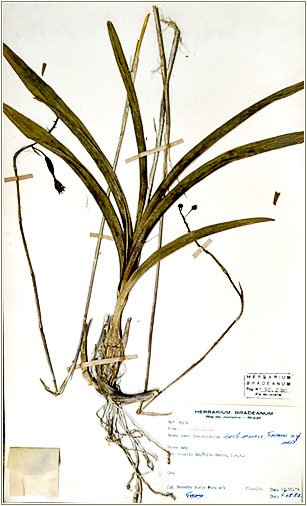 |
The third one is the 70230 file where is written: Pseudolaelia
burle-marxii Toscano n sp. inedit. Loc. Brazil - Espírito
Santo, collected by Roberto Burle Marxi, blooming in culture in
19.1079 and identified by Toscano in 04.08.82.
(not described)
|
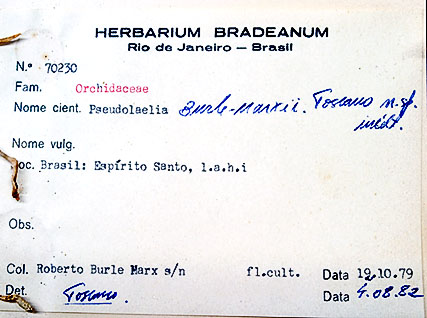 |
Cultivation:
This genus is not spread found in particular collection. In general,
they should be cultivated under intermediate conditions, almost exposed
to the sun. Although Rio de Janeiro has a hot climate, Pseudolaelia
corcovadensis and Pseudolaelia vellozicola are cultivated
in Rio de Janeiro, at the Botanical Garden, however it is surrounding
by the forest which makes the temperature drops every day at night,
all year along.
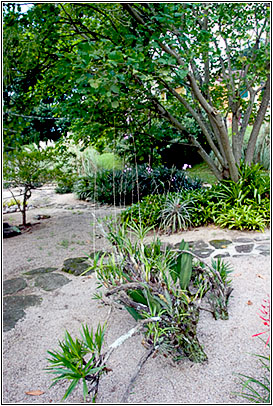 |
Pseudolaelia
corcovadensis is cultivated in the Botanical Garden of Rio
de Janeiro outside in full sun on a compact Vellozia which grows
in sandy soil (at sea level).
|
|
Pseudolaelia vellozicola is cultivated in the Botanical
Garden of Rio de Janeiro under strong luminosity inside the greenhouse. |
Synonyms:
Pseudolaelia auriculata Brieger = Pseudolaelia vellozicola
(Hoehne) Porto & Brade
Pseudolaelia luteola Brieger (Invalid name) = Pseudolaelia
citrina Pabst
Pseudolaelia lymansmithii R.J.V. Alves = Epidendrum campestre
Lindl
Renata canaanensis Ruschi = Pseudolaelia canaanensis (Ruschi)
F. Barros
Schomburgkia vellozicola Hoehne = Pseudolaelia vellozicola
(Hoehne) Pôrto & Brade
Thank:
We would like to Dr. Guy Chiron, the director of Richardiana, Michel
Frey and Vitorino P. Castro Neto for authorizing the reproduction of
the species recently and Elsie Guimar, Director of Herbarium Bradeanum
and Paulo Ormindo for their kind assistance and authorization for reproduction
the documents belong to Herbarium Bradeanum (which are signalized with
a (*).
Bibliography:
1)
Barros, Fábio de - Notas taxonômicas para espécies
brasileiras dos gêneros Epidendrum e Heterotaxis (Orchidaceae)
- Hoehnea - volume 29
2) Chiron, Guy R. & Vitorino P. Castro Neto - Richardiana Vol IV(4)
- 155.162-2005 - Contribution à la connaissance des orchidées
du Brésil, - une nouvelle espéce de Pseudolaelia (Orchidaceae:
Laeliinae) d'Espírito Santo.
3) Frey, Michel- Richardiana Vol V(3) - 158.164-2005 - Pseudolaelia
x perimii M. Frey (Orchidaceae), un hybride naturel nouveau
de l'Espírito Santo (Brésil)
4) Frey, Michel - Richardiana Vol V(4) - 202.209-2005 - Pseudolaelia
pavopolitana M. Frey (Orchidaceae), une nouvelle espèce
de l'Espírito Santo, Brésil
5) Frey, Michel - Richardiana Vol V(1) - 39.45-2005 - Pseudolaelia
maquijiensis M. Frey, une nouvelle espéce d'Orchidaceae
de l'Espírito Santo, Brésil;
6) Hoehne, F.C. - Iconografia de Orchidaceas do Brasil - Secretaria
de Agricultura do Estado de São Paulo, pages 98,114, 210, Table
138
7) Pabst G. F.J. & F. Dungs, 1975 - Orchidaceae Brasilienses - Vol
1- K. Schmersow, Hildesheim
8) Pabst, G. F. J. - Bradea Vol I (36)- 365.367 & 369-1973 - Additamenta
ad Orchideologiam Brasiliensem - XV
9) Pabst, G. F. J. - Bradea Vol I (12)- 69.70- 1976 - Additamenta ad
Orchideologiam Brasiliensem - XXI
10) Withner, Carl L.- 1993. The Cattleyas and Their Relatives, Volume
III, 105-109, Timber Press, Portland USA
11) Florística e ecologia das Orchidaceae do Estado do Espírito
Santo, Cláudio Nicoletti de Fraga e Ariane Luna Peixoto
12) Missouri Botanical Garden. http://mobot.mobot.org/W3T/Search/vast.html
13) Bradea vol I (36)- 1973; Bradea vol II(12)- 1976; Bradea 9(8):33-36-
2003;
14) Orquídea 29: 63. 1967.
15) Orquideas 275:277 - setembro-outubro 1966.
16) Guido Pabst cards - Hebarium Bradeanum.
Photos
and digital manipulations: Sergio Araujo
| Any
kind of reproduction (print, digital or anyone) of any type
of material of this site: texts, layout, photos, images and
others - is strictly
forbidden without previous written permission of the authors.
Any solicitation or information should be done by the e-mil:
bo@sergioaraujo.com |
|


